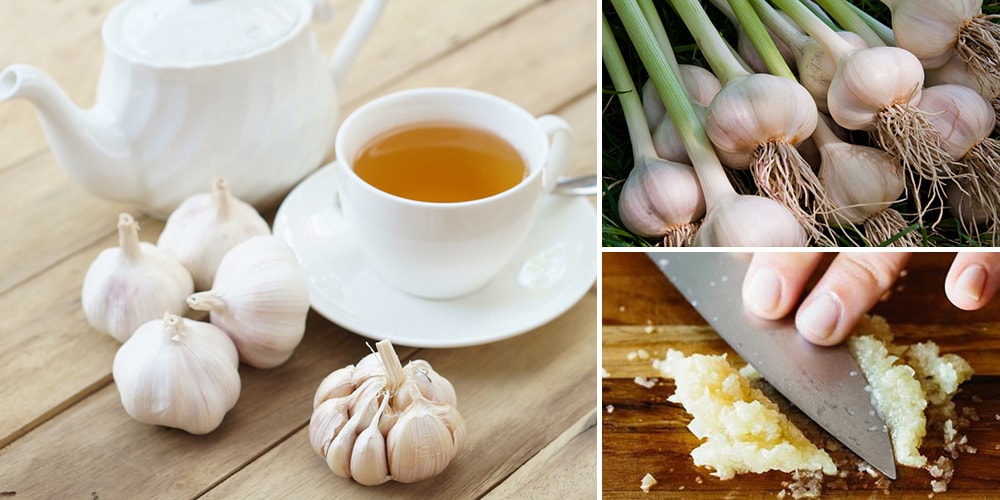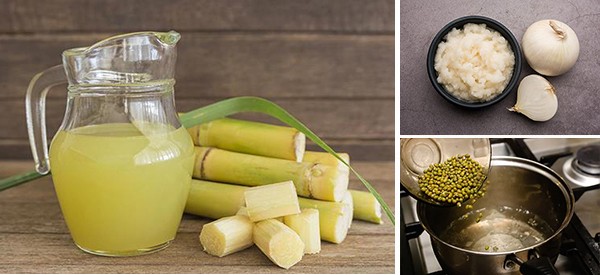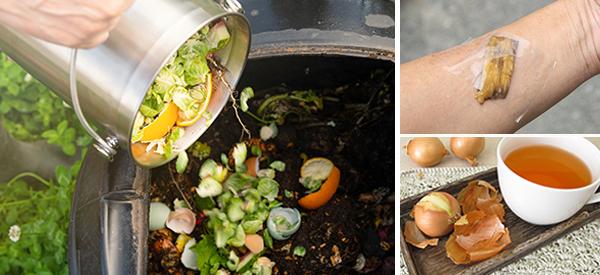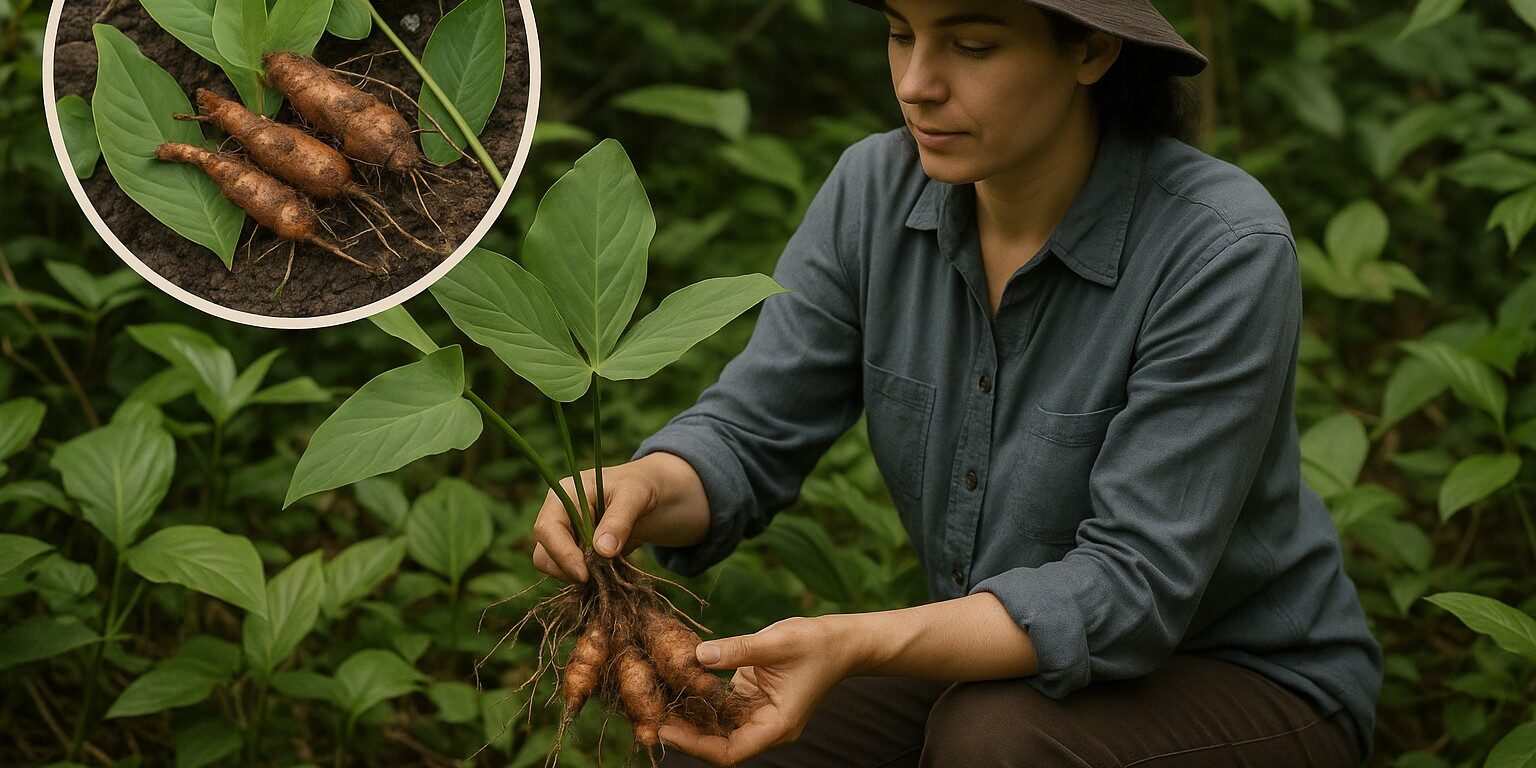
Arrowroot
“A gentle healer from the tropics with ancient roots and modern magic”
What is Arrowroot?
Arrowroot is a tropical plant prized for its edible rhizomes, which are processed into a fine, starchy powder. The starch is gluten-free, grain-free, and easily digestible, making it a staple in natural remedies and gentle diets. While often associated with the plant Maranta arundinacea, the term “arrowroot” can also refer to similar starches from other tropical species. However, Maranta is considered the true arrowroot.
History and Folklore
The name “arrowroot” is believed to come from the Caribbean Arawak word aru-aru, meaning “meal of meals.” Folklore also suggests the plant was used by indigenous people to draw out poison from arrow wounds—hence the English name.
Arrowroot has a long history of cultivation in Central and South America, with archaeological evidence of its use dating back thousands of years. It became highly valued during the colonial era as a soothing remedy for digestive issues and was widely exported to Europe and North America.
Medicinal Benefits
Arrowroot’s gentle nature makes it suitable for sensitive individuals, infants, and those recovering from illness. Traditionally, it has been used for:
- Digestive health: Its demulcent and absorbent properties help calm the gastrointestinal tract, making it useful for diarrhea, IBS, and acid reflux.
- Soothing inflammation: Applied topically, arrowroot powder can reduce irritation, inflammation, and minor skin infections.
- Oral health: Used as a mild poultice for mouth ulcers or teething babies.
- Nutritional support: The resistant starch in arrowroot feeds beneficial gut bacteria, helping to balance the microbiome.
- Immune support: Its trace minerals and prebiotic effects may enhance immunity.
Nutritional Profile
Arrowroot is low in calories and fat but rich in:
- Complex carbohydrates (resistant starch)
- B-vitamins (especially folate and niacin)
- Small amounts of potassium, iron, and magnesium
- Gluten-free and grain-free, suitable for sensitive digestive systems
 How to Forage Arrowroot
How to Forage Arrowroot
Foraging true arrowroot (Maranta arundinacea) in the wild requires care, plant knowledge, and a respectful approach to the land. While it’s more common to cultivate arrowroot, wild patches can be found in tropical or subtropical regions, especially near disturbed ground, forest edges, or streambanks.
Where to Look
- Geographic Range: Native to Central and South America, arrowroot has naturalized in parts of the southern United States, the Caribbean, Southeast Asia, and India.
- Habitat: Look for moist, shaded environments such as jungle clearings, understory areas of tropical forests, or along the edges of wet fields and ditches.
- Soil: Prefers loose, loamy soil that drains well—often in areas with decaying organic matter.
How to Identify Arrowroot
To distinguish true arrowroot (Maranta arundinacea) from look-alikes:
- Leaves: Bright green, smooth, ovate-lanceolate leaves about 4–8 inches long. They resemble calathea or prayer plant leaves (to which they’re related).
- Growth Pattern: Arrowroot grows in small clumps from rhizomes underground. The stems are reed-like and can grow up to 3–6 feet tall.
- Flowers: Small, white to pale purple, non-showy flowers that emerge on slender spikes. Not always present.
- Rhizomes: Tubular, jointed, white to creamy-yellow, about the size of a finger. When broken open, they appear starchy and moist.
Important: Don’t confuse arrowroot with Canna edulis (Queensland arrowroot) or Curcuma longa (turmeric), which have similar underground tubers but different leaves and uses. Always use a reliable field guide or consult an expert before foraging.
How to Harvest
- Best Time: Late in the growing season, typically 10–12 months after sprouting or when the leaves begin to yellow and die back.
- Tools: Use a small digging stick, hori-hori knife, or garden trowel.
- Technique:
- Carefully dig around the base of the plant to expose the rhizomes.
- Gently loosen the soil and lift out the tubers.
- Shake off excess soil and re-cover the hole to minimize environmental disturbance.
Ethical Foraging Practices
- Take Only What You Need: Leave at least two-thirds of any rhizome cluster to allow regeneration.
- Avoid Overharvesting: Forage only from abundant, healthy patches.
- Leave No Trace: Backfill your digging site and avoid damaging nearby roots or young plants.
- Know the Law: Be aware of local foraging regulations, especially if you’re on public or protected land.
Post-Foraging Processing
- Wash thoroughly to remove all dirt.
- Peel the rhizomes with a vegetable peeler.
- Grate, soak in water, and strain to extract the starch (as described in the “How to Grow” section).
 How to Use Arrowroot
How to Use Arrowroot
Internal Uses
- Digestive Aid Tea:
- Mix 1 teaspoon of arrowroot powder with cold water to make a slurry.
- Add the slurry to 1 cup of hot (not boiling) water or milk.
- Sweeten with honey if desired. Drink warm to soothe the stomach.
- Anti-Diarrheal Remedy:
- Combine 1 tablespoon of arrowroot powder with mashed ripe banana and a pinch of salt. Consume 1–2 times daily.
External Uses
- Skin Powder:
- Use arrowroot powder on skin folds or rashes as a talc-free, gentle absorbent.
- Poultice for Infections:
- Mix arrowroot powder with a few drops of water or herbal infusion (like calendula) to make a paste. Apply to minor wounds or bites.
 Culinary Uses of Arrowroot
Culinary Uses of Arrowroot
Arrowroot starch is a prized gluten-free thickener and is especially valued for its neutral flavor, clear finish, and ease of digestion. It’s ideal for those with celiac disease or grain sensitivities.
As a Thickener
- How to Use: Mix arrowroot powder with cool water (1:2 ratio) to make a slurry. Stir into hot dishes at the end of cooking.
- Ideal for: Clear soups, gravies, custards, fruit glazes, sauces, and pie fillings.
- Note: Unlike cornstarch, arrowroot thickens at a lower temperature and should not be boiled extensively, or it may break down.
In Baking
- Adds a light, crisp texture to baked goods.
- Can replace cornstarch in recipes 1:1.
- Binder for Gluten-Free Baking: Helps give structure to gluten-free flours in cookies, muffins, or biscuits.
As an Egg Substitute
- Mix 2 tablespoons arrowroot with 3 tablespoons water to replace 1 egg in baking.
In Herbal and Functional Recipes
- Soothing Porridge: Combine arrowroot starch with warm almond milk and honey for a gentle, gut-healing breakfast.
- Detox Smoothie Boost: Add a teaspoon to smoothies for digestive support.
- Homemade Electrolyte Drink: Mix arrowroot powder with coconut water, a pinch of sea salt, and lemon juice to replenish fluids during illness or heat.
 How to Grow Arrowroot
How to Grow Arrowroot
Arrowroot (Maranta arundinacea) is relatively easy to grow in warm, humid climates. It’s a rewarding plant for both gardeners and herbalists because the rhizomes can be harvested and processed into your own natural starch.
Growing Conditions
- Climate: Arrowroot thrives in tropical and subtropical regions, with temperatures ranging from 70–90°F (21–32°C). It does not tolerate frost.
- Soil: Prefers loose, sandy-loamy soil that’s rich in organic matter. Good drainage is essential to prevent rot.
- Sunlight: Grows best in partial shade or filtered sunlight. It can tolerate full sun if the soil remains moist.
Planting
- Propagation: Arrowroot is propagated from rhizome segments. Each piece should have at least one “eye” or bud.
- Spacing: Plant rhizomes 3–5 inches deep and 12–18 inches apart to allow for root expansion.
- Watering: Requires consistent moisture, especially during dry spells. Mulching helps retain soil moisture and suppress weeds.
Maintenance
- Feeding: Enrich soil with compost or well-rotted manure before planting. A balanced organic fertilizer every 6–8 weeks promotes healthy growth.
- Pests & Diseases: Generally pest-resistant. Watch for root rot in overly wet soil and occasional aphid infestations on leaves.
Harvesting
- Rhizomes are ready for harvest 8–12 months after planting, typically when the leaves begin to yellow and die back.
- Carefully dig up the plant, separate the rhizomes, and rinse thoroughly.
- To make your own starch: Peel, grate, and soak the rhizomes in water. Strain and let the liquid sit so the starch settles. Dry the starch and store it in an airtight container.
Container Growing
Arrowroot can be grown in large pots (at least 12 inches deep) on patios or balconies, making it suitable for cooler climates if brought indoors in winter.
Cautions and Considerations
While arrowroot is extremely gentle and considered one of the safest herbal starches available, there are still a few considerations to keep in mind:
Safety Profile
- Safe for All Ages: Arrowroot is often used for infants and the elderly due to its non-irritating, easily digestible nature.
- Pregnancy & Lactation: Generally regarded as safe, but consult a qualified healthcare provider before using therapeutically.
- Diabetes: Though low on the glycemic index, it can still affect blood sugar levels. Diabetics should monitor intake.
Digestive Reactions
- In rare cases, overuse may lead to constipation due to its absorbent nature. Always consume with adequate fluids.
Cooking Cautions
- Heat Sensitivity: Do not overboil or expose arrowroot to prolonged high heat. This can degrade its thickening power and produce a slimy texture.
- Acidic Ingredients: May not work as effectively in recipes with high acidity (like lemon juice or vinegar).
Interactions
- No known drug interactions, but if used medicinally in conjunction with pharmaceutical treatments, discuss with your doctor.
Storage
- Keep arrowroot powder in a tightly sealed container away from light and moisture. It can last up to 2–3 years when stored properly.
Final Thoughts
Arrowroot is a humble yet powerful ally in natural health. From calming troubled stomachs to supporting skin and digestion, its gentle, grounding energy has earned it a revered place in herbal traditions across the world. Whether in your kitchen or herbal cabinet, this tropical rhizome offers both nourishment and healing.
You may also like:
A Simple “At-Home” Protocol for the Flu and Other Respiratory Issues (Video)
How to Make an Activated Charcoal Poultice
Breathe Easy: How Mullein Can Help Your Lungs
The Best Tea for Colds: Soothing Brews to Help You Feel Better Fast






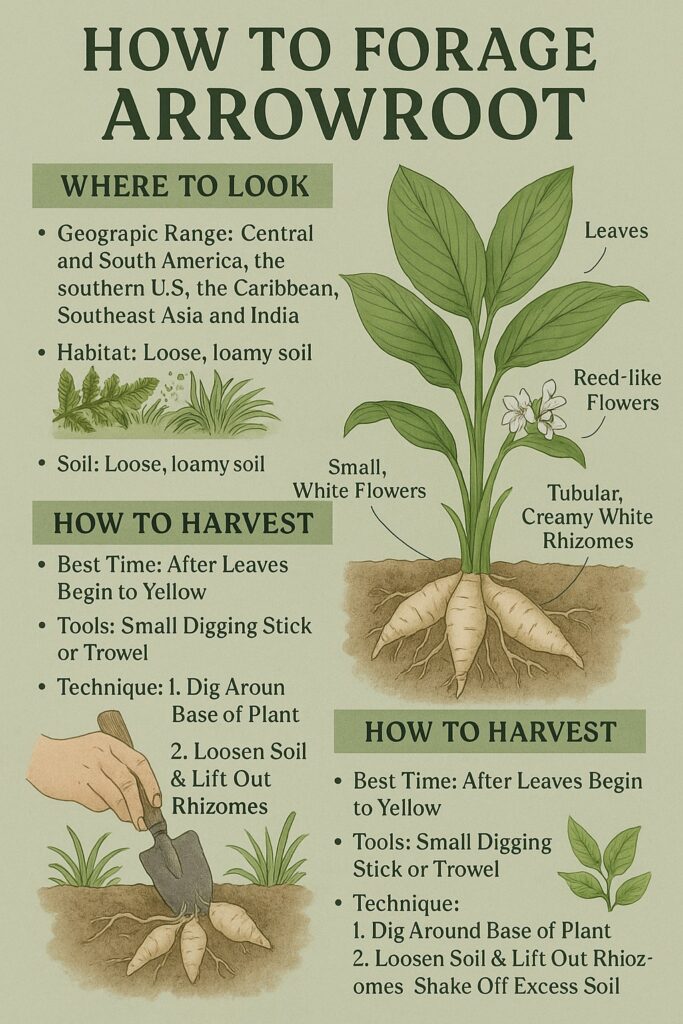 How to Forage Arrowroot
How to Forage Arrowroot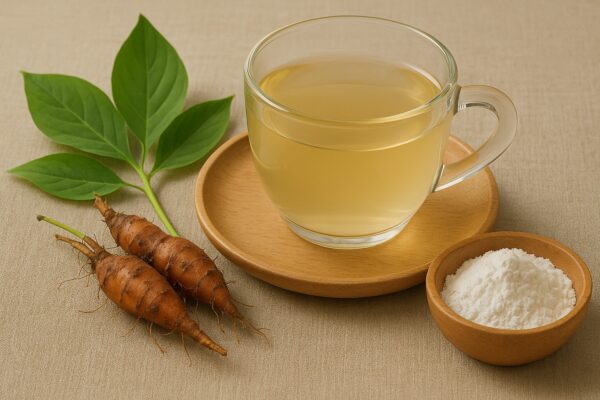 How to Use Arrowroot
How to Use Arrowroot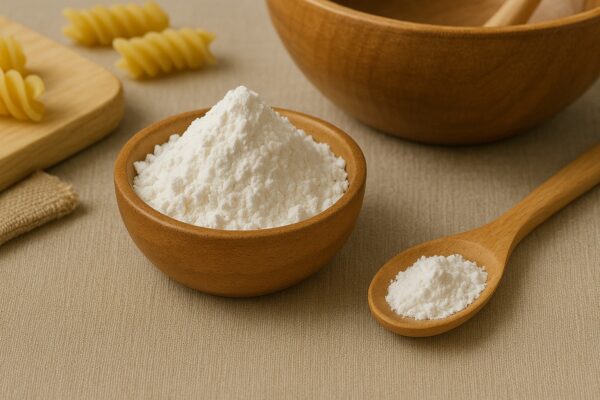 Culinary Uses of Arrowroot
Culinary Uses of Arrowroot How to Grow Arrowroot
How to Grow Arrowroot
